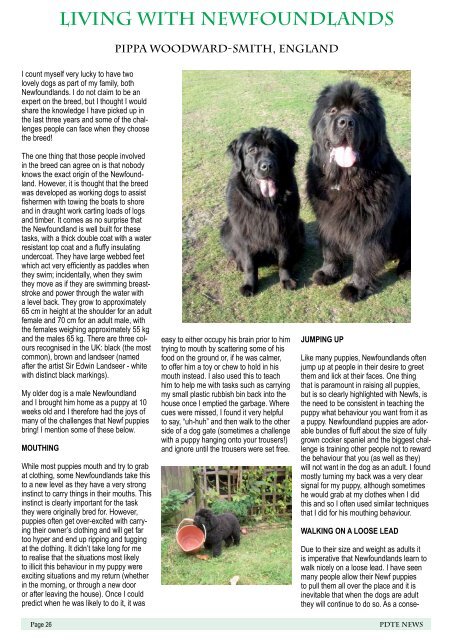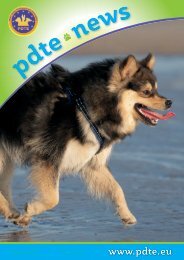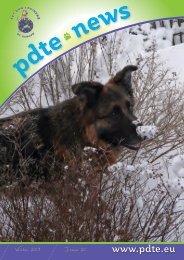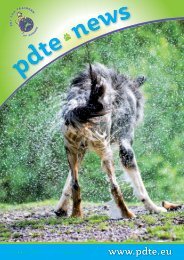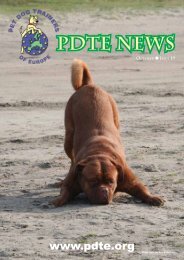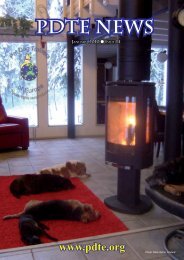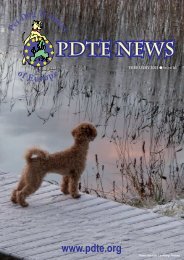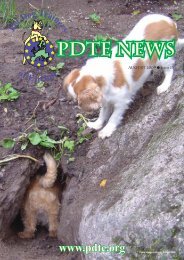PDTE 2011 July Newsletter
Create successful ePaper yourself
Turn your PDF publications into a flip-book with our unique Google optimized e-Paper software.
Living with Newfoundlands<br />
Pippa Woodward-Smith, England<br />
I count myself very lucky to have two<br />
lovely dogs as part of my family, both<br />
Newfoundlands. I do not claim to be an<br />
expert on the breed, but I thought I would<br />
share the knowledge I have picked up in<br />
the last three years and some of the challenges<br />
people can face when they choose<br />
the breed!<br />
The one thing that those people involved<br />
in the breed can agree on is that nobody<br />
knows the exact origin of the Newfoundland.<br />
However, it is thought that the breed<br />
was developed as working dogs to assist<br />
fishermen with towing the boats to shore<br />
and in draught work carting loads of logs<br />
and timber. It comes as no surprise that<br />
the Newfoundland is well built for these<br />
tasks, with a thick double coat with a water<br />
resistant top coat and a fluffy insulating<br />
undercoat. They have large webbed feet<br />
which act very efficiently as paddles when<br />
they swim; incidentally, when they swim<br />
they move as if they are swimming breaststroke<br />
and power through the water with<br />
a level back. They grow to approximately<br />
65 cm in height at the shoulder for an adult<br />
female and 70 cm for an adult male, with<br />
the females weighing approximately 55 kg<br />
and the males 65 kg. There are three colours<br />
recognised in the UK: black (the most<br />
common), brown and landseer (named<br />
after the artist Sir Edwin Landseer - white<br />
with distinct black markings).<br />
My older dog is a male Newfoundland<br />
and I brought him home as a puppy at 10<br />
weeks old and I therefore had the joys of<br />
many of the challenges that Newf puppies<br />
bring! I mention some of these below.<br />
Mouthing<br />
While most puppies mouth and try to grab<br />
at clothing, some Newfoundlands take this<br />
to a new level as they have a very strong<br />
instinct to carry things in their mouths. This<br />
instinct is clearly important for the task<br />
they were originally bred for. However,<br />
puppies often get over-excited with carrying<br />
their owner’s clothing and will get far<br />
too hyper and end up ripping and tugging<br />
at the clothing. It didn’t take long for me<br />
to realise that the situations most likely<br />
to illicit this behaviour in my puppy were<br />
exciting situations and my return (whether<br />
in the morning, or through a new door<br />
or after leaving the house). Once I could<br />
predict when he was likely to do it, it was<br />
easy to either occupy his brain prior to him<br />
trying to mouth by scattering some of his<br />
food on the ground or, if he was calmer,<br />
to offer him a toy or chew to hold in his<br />
mouth instead. I also used this to teach<br />
him to help me with tasks such as carrying<br />
my small plastic rubbish bin back into the<br />
house once I emptied the garbage. Where<br />
cues were missed, I found it very helpful<br />
to say, “uh-huh” and then walk to the other<br />
side of a dog gate (sometimes a challenge<br />
with a puppy hanging onto your trousers!)<br />
and ignore until the trousers were set free.<br />
Jumping up<br />
Like many puppies, Newfoundlands often<br />
jump up at people in their desire to greet<br />
them and lick at their faces. One thing<br />
that is paramount in raising all puppies,<br />
but is so clearly highlighted with Newfs, is<br />
the need to be consistent in teaching the<br />
puppy what behaviour you want from it as<br />
a puppy. Newfoundland puppies are adorable<br />
bundles of fluff about the size of fully<br />
grown cocker spaniel and the biggest challenge<br />
is training other people not to reward<br />
the behaviour that you (as well as they)<br />
will not want in the dog as an adult. I found<br />
mostly turning my back was a very clear<br />
signal for my puppy, although sometimes<br />
he would grab at my clothes when I did<br />
this and so I often used similar techniques<br />
that I did for his mouthing behaviour.<br />
Walking on a loose lead<br />
Due to their size and weight as adults it<br />
is imperative that Newfoundlands learn to<br />
walk nicely on a loose lead. I have seen<br />
many people allow their Newf puppies<br />
to pull them all over the place and it is<br />
inevitable that when the dogs are adult<br />
they will continue to do so. As a conse-<br />
Page 26 <strong>PDTE</strong> NEWS


